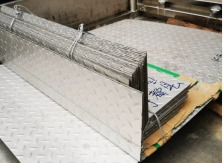In pharmaceutical environments, maintaining a clean, safe, and durable workspace is of paramount importance. The materials used in these settings must meet stringent hygiene standards while also being robust enough to withstand the demands of daily operations. One such material that excels in these environments is the stainless steel checker plate, often provided by stainless steel sheet suppliers. Known for its durability, corrosion resistance, and ease of cleaning, stainless steel checker plate offers a range of benefits that make it an ideal choice for pharmaceutical facilities.
Durability and Strength
Stainless steel checker plate is highly durable and strong, making it well-suited for high-traffic areas in pharmaceutical environments. The material’s tensile strength can reach up to 590 MPa, which allows it to withstand the pressures of heavy loads and constant use. The raised diamond or teardrop patterns on the plate provide added structural integrity, preventing deformation even under the stress of continuous movement of equipment and materials. Additionally, its hardness is measured between 201 and 230 on the Brinell scale, and it boasts high impact resistance. These properties ensure that stainless steel checker plate remains both functional and visually appealing even after extensive use.
Corrosion Resistance
In pharmaceutical settings, exposure to various chemicals and cleaning agents is common. Stainless steel checker plate offers excellent corrosion resistance, particularly when using grades such as 304 or 316 stainless steel. This resistance is critical in environments where cleanliness and sterility are non-negotiable.
Stainless steel checker plate is especially resistant to corrosion, making it an excellent choice for environments that frequently use harsh chemicals like sodium hypochlorite or hydrogen peroxide. While stainless steel checker plate handles these chemicals excellently, alternative materials like mild steel checker plate perform poorly under similar conditions. Stainless steel’s inherent corrosion resistance ensures that the checker plate will not degrade or rust when exposed to such harsh chemicals, extending the lifespan of the flooring and maintaining the integrity of the sterile environment.
Slip Resistance
Safety is a top priority in pharmaceutical environments, where slips and falls can lead to contamination or injury. The textured surface of **stainless steel checker plate** provides excellent slip resistance, even when wet or coated with chemicals. This makes it an ideal choice for areas prone to spills, such as near sinks, production lines, and storage areas.
The slip-resistant nature of stainless steel checker plate helps to prevent accidents, thereby protecting both the staff and the integrity of the pharmaceutical products being handled. Even under dry conditions, the coefficient of friction is high at 0.85. When the surface is wet, it remains sufficiently slip-resistant with a coefficient of 0.65, and even in oily conditions, it offers a reasonable coefficient of 0.55. Its reliability in reducing slip hazards makes it a vital component of any facility’s safety measures.
Hygienic Properties
Maintaining a hygienic environment is crucial in pharmaceutical settings, where contamination can have serious consequences. Stainless steel checker plate is non-porous, which means it does not harbor bacteria or other pathogens. Its smooth surface is easy to clean and sanitize, ensuring that the highest levels of hygiene can be maintained.
Additionally, stainless steel does not support the growth of mold or mildew, which can be a concern in areas with high humidity or frequent cleaning. The ability to thoroughly clean and disinfect the material quickly and effectively makes it a superior choice for pharmaceutical applications, supporting high sanitation standards.
Aesthetic and Reflective Properties
Beyond its functional benefits, stainless steel checker plate also offers aesthetic advantages. Its bright, reflective surface enhances the lighting within a facility, which is particularly beneficial in environments where visibility is essential. The clean, professional appearance of stainless steel checker plate adds to the overall image of a pharmaceutical facility, reinforcing the commitment to quality and cleanliness.
The reflective properties can also contribute to energy savings by improving the efficiency of the existing lighting systems. This, coupled with the material’s long-lasting performance, makes it a cost-effective choice in the long term.
Easy Installation and Maintenance
Installing stainless steel checker plate is straightforward, and once in place, it requires minimal maintenance. The material can be quickly cut and shaped to fit any space, and it can be securely fastened to various substrates. This ease of installation ensures that pharmaceutical facilities can implement it quickly, minimizing downtime.
Maintenance is also simplified with stainless steel checker plate. It can withstand frequent cleaning with harsh chemicals without deteriorating, and it does not require special treatments to maintain its appearance or performance. This durability, combined with low maintenance needs, translates to lower overall costs for the facility.
Conclusion
In pharmaceutical environments, where hygiene, safety, and durability are paramount, stainless steel checker plate proves to be an outstanding material choice. Its durability, corrosion resistance, slip resistance, and hygienic properties make it a reliable and cost-effective option for flooring and other surfaces. Additionally, its aesthetic appeal and ease of maintenance further enhance its suitability for such demanding environments.
By choosing stainless steel checker plate, pharmaceutical facilities can ensure that they maintain a clean, safe, and efficient workspace that meets the highest industry standards. Whether it’s in laboratories, production areas, or storage rooms, stainless steel checker plate offers unmatched benefits that contribute to the overall success and safety of the operation.



